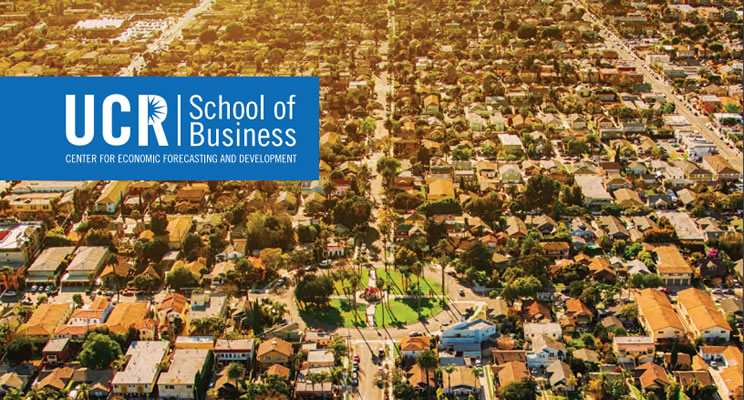10th Annual Inland Empire Economic Forecast Conference:
Housing Remains Greatest Immediate and Longer Term Challenge; Despite Some Trade War Impacts and Yield Curve Consternation, Neither Will Lead To A Downturn in 2020.
Riverside, Ca — Operating at ‘full employment’ and with an unemployment rate that is trending lower than its record low, the Inland Empire’s economy will continue to grow through 2020, although at a slower pace than in the recent past, according to a new economic forecast released today by the UC Riverside School of Business Center for Economic Forecasting and Development at the 10th annual Inland Empire Economic Forecast Conference.
Driving much of the region’s ongoing jobs growth are the local health care and logistics sectors, while significant growth at the Ontario International Airport is showcasing the Inland Empire’s increasingly strong economic presence among Southern California’s powerhouse economies.
“The IE economy has been gaining momentum in recent years and although there has been a slowdown, based on everything we see happening today, all the handwringing over a coming recession is just that – nothing on the foreseeable horizon would have a big enough or rapid enough impact to knock the region, or the nation, into a downturn,” said Christopher Thornberg, Director of the UC Riverside School of Business Center for Economic Forecasting and one of the forecast authors. “Although there is always the potential for some yet unseen impact on the global or national level, and there are certainly long term threats that stem from California’s statewide housing shortage, which is helping to drive labor shortages, slower growth is expected to continue.”
The new forecast calls out a lack of housing supply and weak rates of homebuilding, particularly within the single-family market, as the most urgent challenge to economic growth in the Inland Empire. Even though local housing stock falls seriously short of demand, residential building permits in the region (both single-family and multifamily) declined by 8.2% in the first half of 2019 compared to the same period one year ago.
This is not unique in Southern California where Los Angeles saw residential permits fall by a much higher 27.9% and San Diego experienced a whopping 46.6% decline. Indeed, construction has pulled back statewide with residential permits down 17.4% across California compared to last year. The Inland Empire’s multifamily building activity has been stronger and that is likely what has moderated the region’s relatively lower level of decline in residential permits.
“The consequence of high demand and low supply is, of course, upward pressure on home prices and rental costs,” said Thornberg. “Both have increased substantially in the Inland Empire over the past year as the number of home sales has declined. This is a problem today and unless we add housing stock, is going to be even more of a problem tomorrow.”
The new forecast delivers current outlooks for the U.S., California and Inland Empire economies.
Select Key Findings:
- Of all the industrial and business development in the Inland Empire, rapid expansion occurring at the Ontario International Airport is a stand out in Southern California. Year-over-year growth in passenger traffic at the airport has jumped by 9.6% compared to 0.3% growth at LAX and a 3.4% contraction at John Wayne Airport in Orange County.
- Due to the multiple ways that employment is measured by the U.S. Bureau of Labor Statistics and the California EDD, and due to a lag in some of the data, the new forecast finds that current monthly figures may be underestimating the Inland Empire’s true jobs growth trends. There is a good chance that growth levels will be revised upward when the annual benchmarking occurs in March 2020.
- Despite the trade war that has been underway with some of California’s most key trading partners since March of 2018, the Inland Empire’s logistics sector has continued to grow at a robust pace with 3% job expansion from August 2018 to August 2019.
- As of the second quarter of 2019, average rent in the Inland Empire reached $1,390/month, a 3.8% year-over-year increase. Notably, rents are most expensive in submarkets closest to Los Angeles County where vacancy rates are also the lowest, indicating higher demand, likely from commuters who drive to the coast for work.
- Sales of existing single-family homes in the Inland Empire were down 6.4% in the first half of 2019 while they fell 7.2% statewide. The pull back can partially be traced to last year’s sharp rise in interest rates and limits on mortgage deductibility that resulted from the Federal ‘Tax Cuts and Jobs Act’. The good news is that 2018’s surge in interest rates has largely been erased and today’s lower rates should stimulate the market in coming quarters.
- Yield curve, schmield curve: The strong correlation in this data to the onset of a recession is traditionally driven by the Fed raising short-term interest rates to cool an overheating economy. The inverted yield curve is like the skid marks left behind after trying to avoid going over a cliff. But in this case, the United States is not facing a cliff. The national economy is stable and the expansion will continue.
The 10th annual Inland Empire Economic Forecast Conference is being held on November 6th at the Riverside Convention Center in Riverside, CA. In addition to forecasts for the nation, state, and region, the event includes a drilled down discussion with renowned housing policy experts Dr. Paavo Monkkonen and Steve PonTell about California’s intensifying home affordability crisis and possible policy prescriptions to address the state’s lack of home building.
[/vc_column_text][/vc_column][/vc_row]

